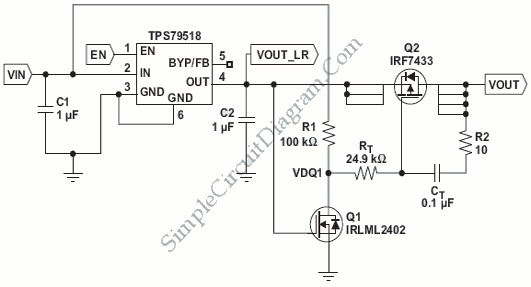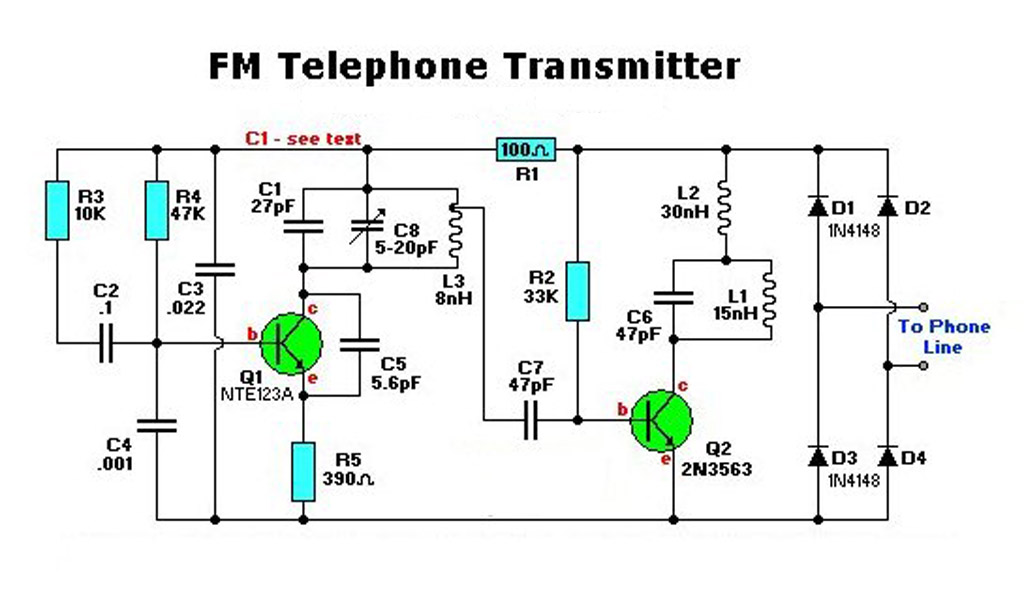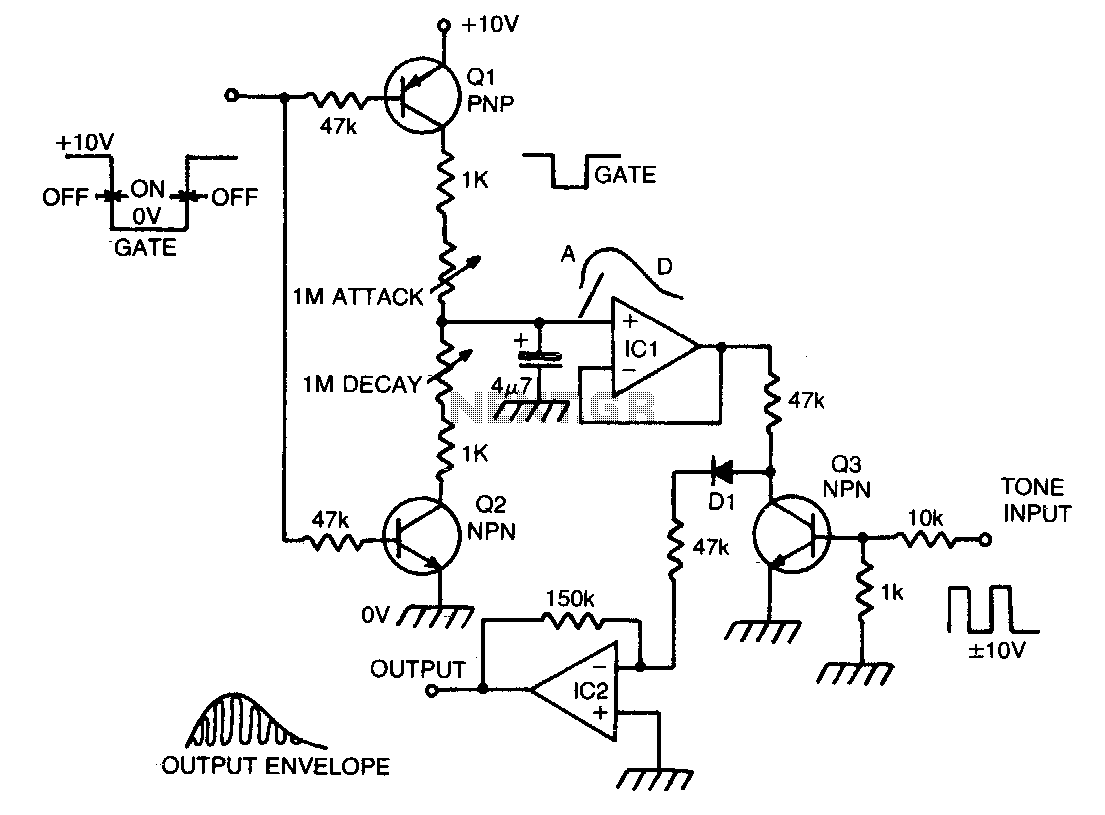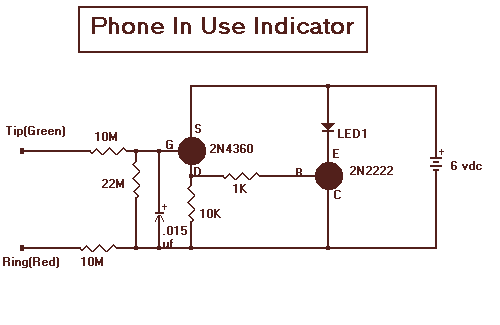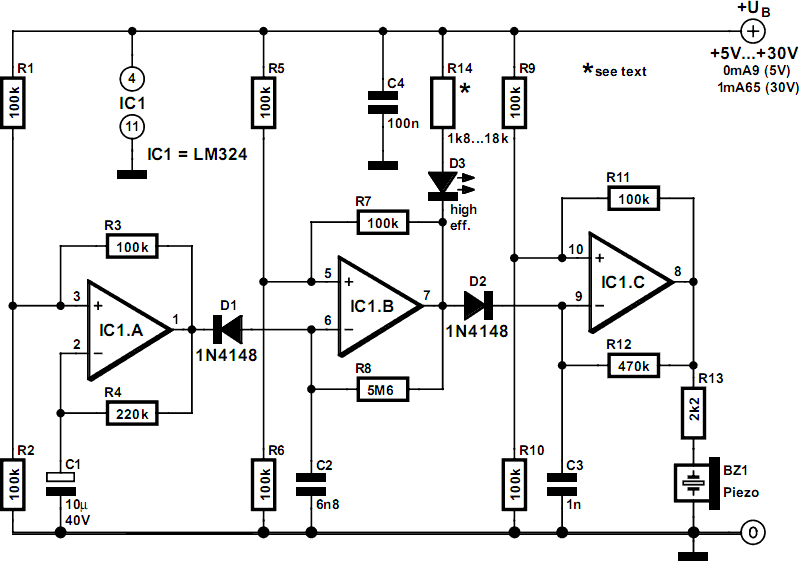
Soft Musical Telephone Ringer by UM66T
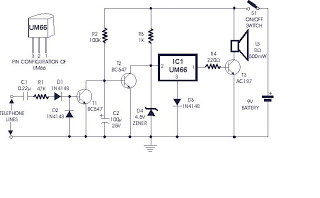
The incoming ring is detected by transistor T1 and the components connected to it. In the absence of a ringing voltage, transistor T1 is in the off state while transistor T2 is forward biased due to resistor R2 being connected to the positive supply rails. Consequently, the collector of transistor T2 is at a near-ground potential, which keeps IC1 (UM66) off. Additionally, capacitor C2 is charged to a slightly positive potential. During the positive half of the ringing voltage, diode D1 forward biases transistor T1, rapidly discharging capacitor C2 to near ground potential and turning off transistor T2. This action causes IC1 to be forward biased, allowing a music signal to be applied to the base of transistor T3, which drives the speaker. During the negative half of the ringing voltage, capacitor C2 cannot charge quickly through resistor R2, resulting in transistor T2 remaining off throughout the ringing interval.
The circuit operates as a ringing detector and audio signal generator, utilizing a combination of transistors, resistors, capacitors, and a diode. Transistor T1 serves as the primary detection element for the incoming ringing voltage, while T2 acts as a switch that controls the state of the audio output. Resistor R2 plays a crucial role in biasing T2, ensuring it remains in a conducting state when no ringing voltage is present.
Capacitor C2 is essential for maintaining the circuit's functionality during the ringing intervals. It temporarily stores charge, allowing for rapid discharging through T1 when the ringing voltage is detected. The forward biasing of T1 by the ringing voltage leads to a quick discharge of C2, which effectively transitions T2 to the off state, enabling IC1 to produce an audio output.
Diode D1 ensures that the forward biasing of T1 occurs only during the positive half of the ringing cycle, providing a unidirectional path for the current and protecting the circuit from reverse voltage conditions. The output from IC1 is then fed to the base of transistor T3, which amplifies the audio signal to drive a speaker, producing sound.
This configuration allows the circuit to respond dynamically to the incoming ringing signal, generating an audio output only when a valid ringing voltage is detected. During the negative half of the ringing cycle, the inability of capacitor C2 to charge quickly through R2 ensures that the circuit remains inactive, preventing unwanted audio signals from being generated. The design effectively combines detection and audio generation, making it suitable for applications such as telephone ring signal indicators or alert systems.The incoming ring is detected by transistor T1 and components wired around it. In absence of ringing voltage, transistor T1 is cut off while transistor T2 is forward biased as resistor R2 is returned to the positive supply rails. As a result collector of transistor T2 is at near-ground potential and hence IC1 (UM66) is off. Also capacitor C2 is ch arged to a slightly positive potential. During positive half of the ringing voltage, diode D1 forward biases transistor T1 and rapidly discharges capacitor C2 to near ground potential and cuts off transistor T2 which, in turn, causes IC1 to be forward biased and music signal is applied to base of transistor T3 which drives the speaker. During negative half of the ringing voltage, capacitor C2 cannot charge rapidly via resistor R2 and hence transistor T2 remains cut off during the ringing interval.
🔗 External reference
The circuit operates as a ringing detector and audio signal generator, utilizing a combination of transistors, resistors, capacitors, and a diode. Transistor T1 serves as the primary detection element for the incoming ringing voltage, while T2 acts as a switch that controls the state of the audio output. Resistor R2 plays a crucial role in biasing T2, ensuring it remains in a conducting state when no ringing voltage is present.
Capacitor C2 is essential for maintaining the circuit's functionality during the ringing intervals. It temporarily stores charge, allowing for rapid discharging through T1 when the ringing voltage is detected. The forward biasing of T1 by the ringing voltage leads to a quick discharge of C2, which effectively transitions T2 to the off state, enabling IC1 to produce an audio output.
Diode D1 ensures that the forward biasing of T1 occurs only during the positive half of the ringing cycle, providing a unidirectional path for the current and protecting the circuit from reverse voltage conditions. The output from IC1 is then fed to the base of transistor T3, which amplifies the audio signal to drive a speaker, producing sound.
This configuration allows the circuit to respond dynamically to the incoming ringing signal, generating an audio output only when a valid ringing voltage is detected. During the negative half of the ringing cycle, the inability of capacitor C2 to charge quickly through R2 ensures that the circuit remains inactive, preventing unwanted audio signals from being generated. The design effectively combines detection and audio generation, making it suitable for applications such as telephone ring signal indicators or alert systems.The incoming ring is detected by transistor T1 and components wired around it. In absence of ringing voltage, transistor T1 is cut off while transistor T2 is forward biased as resistor R2 is returned to the positive supply rails. As a result collector of transistor T2 is at near-ground potential and hence IC1 (UM66) is off. Also capacitor C2 is ch arged to a slightly positive potential. During positive half of the ringing voltage, diode D1 forward biases transistor T1 and rapidly discharges capacitor C2 to near ground potential and cuts off transistor T2 which, in turn, causes IC1 to be forward biased and music signal is applied to base of transistor T3 which drives the speaker. During negative half of the ringing voltage, capacitor C2 cannot charge rapidly via resistor R2 and hence transistor T2 remains cut off during the ringing interval.
🔗 External reference
